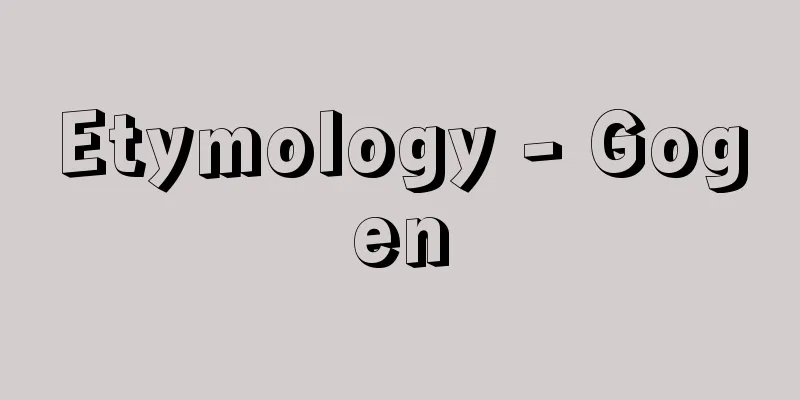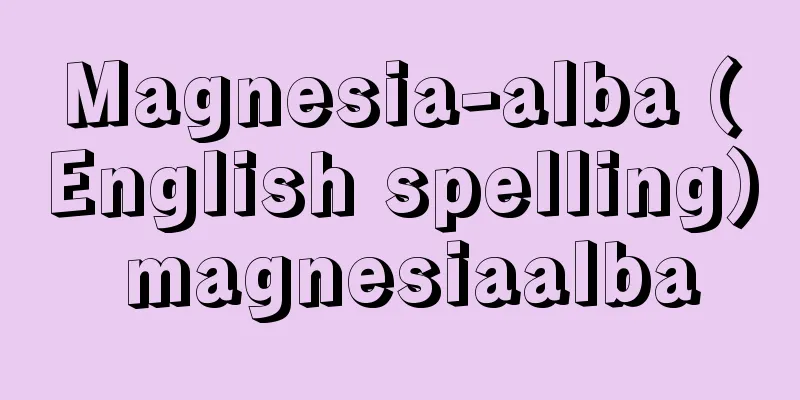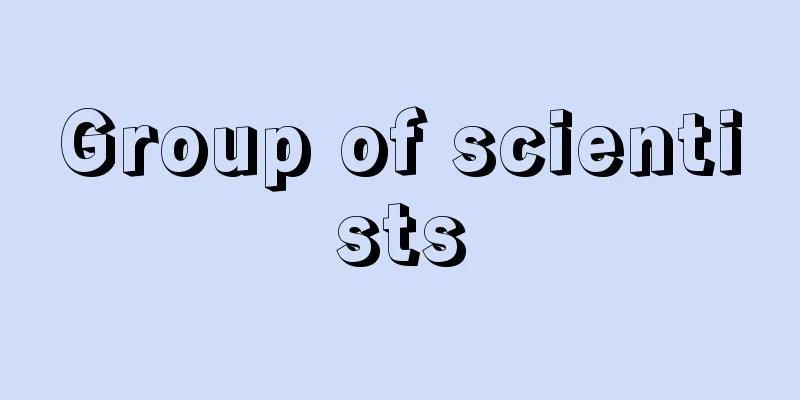Etymology - Gogen

|
When we consider the origin of a word (or phrase) and why it came to be used in a certain way, that origin is called "etymology." For example, "abayo" is sometimes used as a farewell greeting, which is said to be a variant of "anbai ryo." "Anbai" is a combination of "enbai," meaning saltiness or sourness or the amount of flavor, and "anbai," meaning to arrange things in an orderly manner. In this way, the part of linguistics that studies the origin of words is called "etymology" or "etymology," and corresponds to the English word "etymology." The origin of etymology dates back to the Greek word étumon, meaning "the true meaning of a word." This reflects the idea at the time that the etymological meaning is the true meaning, but it is easily misleading. From a later perspective, the etymological meaning is merely an old meaning, and the true meaning is the central meaning hidden in the various uses of the word recognized in each later era. To add an example of a foreign language, the English word "muscle" comes from the Latin word "musculus" (small mouse). This is because the shape and movement of the muscle resembles a mouse. The mus- part corresponds to the English word "mouse". A similar morphological correspondence is seen between the English words "house" and "husband". This hus- means "house", and husband etymologically refers to the "master of the house". The English words "camera" and "chamber" come from the same Greek word kamárā (a room with a cylindrical ceiling). When this word was borrowed into Latin and then into French, the form changed to chambre, which was then borrowed into English. The word "camera" is an abbreviation of the Latin word "camera obscura" (dark box). When ordinary people add an interpretation that differs from the original etymology, it is called "popular etymology (folk etymology)." For example, the juice of the daidai (orange) is called "ponzu," which originally came from the Dutch word pons and was pronounced ponsu. However, the "su" in ponsu became known as meaning vinegar, and so it came to be pronounced ponzu. The English word penthouse, or "rooftop house," was originally pentis, but this was changed to pent house because of the awareness of it as a "house." In this way, ordinary people's interpretations can change the form and meaning of words, so care must be taken. [Yoshinori Yamaguchi and Tetsuya Kunihiro] Problems with etymologySince a word is a combination of sound and meaning, when considering the etymology, explanations of both sound and meaning must be reasonable. For example, in the case of "anbai ryou → abayo," a sound change from anbayou to abayo is quite possible. Also, "anbai" means the state of things, and saying "I hope you're well" is an appropriate farewell greeting. In this way, explanations of etymology must be supported by both sound and meaning. In this respect, many etymological theories from the Edo period or earlier are unreliable. In particular, there are many that do not take this aspect into consideration sufficiently, due to a lack of empirical observations of the possibility of sound change. For example, there is a case where "taka (hawk)" is a variation of "tsumakata (hard claws)." Although it is not impossible in terms of meaning, it is highly unlikely that a sound change like tsumakata → taka could have occurred, and it is not credible. [Yoshinori Yamaguchi and Tetsuya Kunihiro] Etymology and historyWhen considering the etymology, it is necessary to know the origin and history of the word (compound word). It is difficult to arrive at the correct etymology without knowing when and how it appeared, what its original meaning was, and how it has changed since then. The history of such an individual word is called a "word history," and a record of that history is called a "phrase book." However, if etymological research is not based on accurate knowledge of word history, it can lead to unexpected mistakes. For example, pine cones are called "matsubokkuri." It is clear that "matsu" means pine, but it is unlikely that "bokkuri" will arrive at the correct answer if we consider it in this form. However, if we know that this word was originally "matsufuguri," we can see that "fuguri" means scrotum, and that it was named to mean a pine scrotum because of its shape. [Yoshinori Yamaguchi and Tetsuya Kunihiro] Limitations of etymological researchThe word "tsubaki (spit)" is a combination of "tsu", meaning saliva, and "haki", meaning to spit, and this "tsu" also appears in expressions such as "drinking one's hardened saliva" and "the worm's saliva runs". Up to this point, it is easy to explain, but when it comes to the point where it becomes extremely difficult to explain why saliva is called "tsu" and why vomiting is called "haki". In such cases, some people simply pick up nearby foreign words and try to link them to explain the word's origin, but we must be very careful about this. [Yoshinori Yamaguchi and Tetsuya Kunihiro] "The Etymology of Japanese Language by Atsuyoshi Sakakura (Kodansha Gendai Shinsho)" Source: Shogakukan Encyclopedia Nipponica About Encyclopedia Nipponica Information | Legend |
|
ある単語(あるいは連語)が、なぜそういう意味に用いられるようになったかという由来を考えたとき、その由来を「語源」という。たとえば、別れの挨拶(あいさつ)として、「あばよ」ということがあるが、これは「案配(あんばい)良う」の転じた形とされる。また「案配」は、塩味と酸味の意あるいは味加減の意である「塩梅(えんばい)」と、物事を順序よく並べる意の「按排(あんばい)」が混合した語である。このように、語源を研究する言語学の一部を「語源学」または「語源論」といい、英語のetymologyにあたる。etymologyの語源はギリシア語のétumon「語の真の意味」にさかのぼる。これは当時の、語源的意味が真の意味であるという考え方を反映しているが、誤解を招きやすい。後の時代からみれば、語源的意味は単に古い意味にすぎず、真の意味というものは、後の各時代ごとに認められる語の諸用法のなかに潜む中心的な意味である。外国語の例を付け加えると、英語のmuscle「筋肉」はラテン語のmusculus「小さなネズミ」に由来する。これは筋肉の形や動くさまをネズミに見立てたものである。このmus-の部分が英語のmouse「ネズミ」に対応する。同じような語形上の対応が英語のhouse「家」とhusband「夫」の間にみられる。このhus-は「家」であり、husbandは語源的には「家の主人」をさした。英語のcamera「カメラ」とchamber「部屋」は同一のギリシア語kamárā「筒形天井の部屋」に由来する。この語がラテン語に借り入れられ、フランス語の時代になったとき、形がchambreに変わったが、この時点で英語に借り入れられた。cameraのほうは、ラテン語のcamera obscura「暗い箱」の略形である。なお、民衆が本来の語源と異なる解釈を加えることを「語源俗解(民間語源)」と称する。たとえば、ダイダイ(橙)の絞り汁を「ぽんず」というが、本来オランダ語のponsから出たもので、ポンスと発音された。しかし、ポンスのスが酢の意であるという意識が生じたため、ポンズと発音されるようになった。英語のpenthouse「屋上家屋」は古くはpentisであったのを、「家」という意識からpent houseに変えた。このように、民衆の解釈が、語の形や意味を変えたりすることもあるので、注意を要する。 [山口佳紀・国広哲弥] 語源研究の問題点単語は、音と意味との結合体であるから、語源を考える場合、音と意味とのそれぞれについて説明に無理があってはならない。たとえば、「案配良う→あばよ」について、アンバイヨウ→アバヨの音変化は十分におこりうることである。また、「案配」は物事のぐあいの意であり、それが「良くあれ」と言い掛けることは、別れの挨拶としてふさわしい意味をもつ。このように、語源の説明は、音と意味との両面から支持されるものでなくてはならない。この点、江戸時代あるいはそれ以前の語源説には信頼できないものが多い。とくに、音変化の可能性に関する実証的な観察を欠いていたために、その面の配慮が十分でないものが目だつ。たとえば、「たか(鷹)」を「つまかた(爪堅)」の転とするたぐいで、意味的にはありえないことではないが、ツマカタ→タカというような音変化がおこるとはとうてい考えられず、信ずるに足りない。 [山口佳紀・国広哲弥] 語源と語史語源を考える場合に必要なのは、その単語(連語)の素姓、経歴である。いつごろ、どんなふうに現れ、古い意味はどんなであったか、その後どんな変化をたどったかについて知らないと、正しい語源に到達することが困難である。そうした個々の語の経歴を「語史」といい、その経歴を記したものを「語誌」とよぶが、語源研究は、語史に関する精確な知識に基づかないと、思わぬ誤りに陥ることがある。たとえば、松毬(まつかさ)のことを「まつぼっくり」という。「まつ」が松の意であることは明らかであるが、「ぼっくり」は、このままの形で考えても正解に達することはまずあるまい。しかし、この語が古く「まつふぐり」であった事実がわかれば、「ふぐり」は陰嚢(いんのう)のことで、その形状から松の陰嚢の意で命名されたことが判明する。 [山口佳紀・国広哲弥] 語源研究の限界「つばき(唾)」という語は、唾液の意の「つ」に「吐き」のついた形で、この「つ」は「固唾(かたづ)を飲む」「虫唾(むしづ)が走る」などにも現れる。ここまでは説明できるが、唾液をなぜ「つ」というか、嘔吐(おうと)することをなぜ「吐く」というかという点になると、その説明はきわめて困難になる。 こういう場合、安易に周辺の外国語を取り上げ、それと結び付けて語源を説こうとするものがあるが、その点は十分慎重でなくてはならない。 [山口佳紀・国広哲弥] 『阪倉篤義著『日本語の語源』(講談社現代新書)』 出典 小学館 日本大百科全書(ニッポニカ)日本大百科全書(ニッポニカ)について 情報 | 凡例 |
<<: Constitutional protection movement
Recommend
Inugami Mochi - Inugami Mochi
...A type of tsukumono found mainly in Shikoku, e...
Fang
…On the other hand, in Mbini, although there are ...
Yukitoshi Takikawa
Criminal law scholar. His name can also be read a...
Psychiatric expert testimony
There are provisions related to mental disorders ...
Iji Azamaro - Iji no Azamaro
Date of birth and death unknown. Lord Iji. Chief ...
Yen-denominated foreign bonds
⇒ Yen-denominated bonds Source: About Shogakukan D...
Toggenburg
...Due to these characteristics, they are often k...
Seeckt - Hans von Seeckt
German military officer. During World War I, he s...
Saisine
…For this reason, it can be translated as “posses...
Crispinus and Crispinianus
Both are Christian saints. According to legend, th...
Songgwangsa Temple (English name)
A Jogye Order temple in Songgwang-myeon, Seungju-g...
Nelumbo
...It is a perennial aquatic plant of the Nelumbo...
Cilia
…these are motile organelles found on the surface...
Arage flat-headed woodworm beetle - Arage flat-headed woodworm beetle
...The adults and larvae of the oak flat-headed b...
rigidity of soft birth canal
...Premature rupture of the membranes occurs afte...









